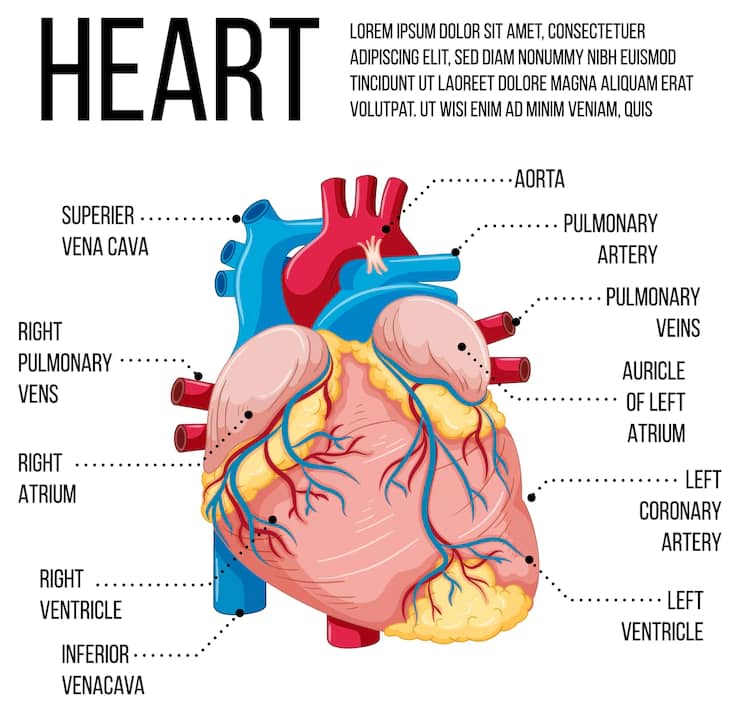How Many Times Does The Heart Beat In A Minute
Introduction
The heart is one of the most vital organs of our body. It is located in our chest slightly to the left. It is the size of our fists and the center of our circulatory system, which plumps blood through our bodies. It is made up of multiple layers of tissues. An average adult’s heart beats 60-100 times in a minute.
Structure of The Heart

Figure 1
Our heart is divided into four chambers. Two are on top called atrium and plural atria, and two are on the bottom called left ventricle and right ventricle. The two large veins deliver deoxygenated blood to the right atrium, from where the blood reaches the right ventricle. The right ventricle pumps blood to the lungs through the pulmonary artery. Then, the oxygenated blood reaches the left atrium, which pumps the blood to the left ventricle, from where it reaches the whole body via the left ventricle.
There are four valves. The tricuspid valve and mitral valve are atrioventricular (AV). While the pulmonary valve and aortic valve are semilunar(SL). The tricuspid valve is between the right atrium and right ventricle, while the mitral valve is the door between the left chambers. The aortic valve assists in blood flow from the left ventricle to the aorta. While the pulmonary valve takes the blood from the right ventricle, where it reaches pulmonary arteries.
Functions Of The Heart
The heart’s main function is to pump blood throughout the body. The heart pumps blood through three vessels: arteries, Veins, and Capillaries. Arties carry oxygenated blood from the heart and take it to the rest of the tissues, while veins are the vessels that carry deoxygenated blood from the body to give it to the heart. And capillaries are the site of exchange of oxygenated and deoxygenated blood in the body.
With the help of the circulatory system, the heart supplies oxygen and nutrients to the tissues, which help generate oxygen. It also controls heart rate and maintains blood pressure throughout the body. Thus, the heart is the major organ that regulates the circulatory system.
Generation of the Heartbeat
The cardiac muscles of the heart help the organ in the conduction of the heartbeat. The walls of the ventricles are thick, while the atria walls are thin. Specialized cardiac tissues, also called nodal tissues, (1) sino-atrial (SA) Nodes, and (2) atrioventricular (AV) Nodes, are also present.
A heartbeat is generated by electrical impulses that travel down through the heart. The sino-atrial node, also called the SA node, the heart’s natural pacemaker, is present in the upper right corner of the right atrium. It initiates and maintains the rhythmic contractions of the heart.
SA nodes activate the atria by generating the electrical impulse, which travels from SA to the AV node, then slowing down the impulse for a short time. Then, it continues to move towards the ventricles via the bundle of His such that ventricles are contracted.
This cycle, where the first two upper chambers are stimulated and contracted, followed by the contraction of the ventricles, generates a heartbeat.
Frequently Asked Questions (FAQs)
The size of a heart is equal to the size of our fists. This size is generally 10 to 12 ounces which is similar to 280 grams to 340 grams for males, and for females, it is 8 to 10 ounces around 230 to 280 ounces.
The heart's main function is to pump blood throughout the body to supply oxygen and nutrients.
Tricuspid valve, Pulmonary valve, Mitral valve, and Aortic valve.
Our heart is divided into four chambers: two at the top and two at the bottom.
An average human's heartbeat rate is 60 - 100 times per minute.
Applications for Admissions are open.
As per latest syllabus. Physics formulas, equations, & laws of class 11 & 12th chapters
JEE Main Important Chemistry formulas
Get nowAs per latest syllabus. Chemistry formulas, equations, & laws of class 11 & 12th chapters
JEE Main high scoring chapters and topics
Get nowAs per latest 2024 syllabus. Study 40% syllabus and score upto 100% marks in JEE
JEE Main Important Mathematics Formulas
Get nowAs per latest syllabus. Maths formulas, equations, & theorems of class 11 & 12th chapters